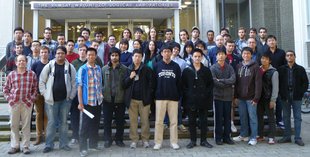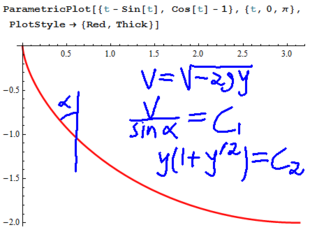12-267: Difference between revisions
No edit summary |
No edit summary |
||
| (42 intermediate revisions by 10 users not shown) | |||
| Line 24: | Line 24: | ||
{{Template:12-267:Dror/Students Divider}} |
{{Template:12-267:Dror/Students Divider}} |
||
[[User:Drorbn|Drorbn]] 06:36, 12 September 2012 (EDT): Material by [[User:Syjytg|Syjytg]] moved to [[12-267/Tuesday September 11 Notes]]. |
|||
===Solving the complicated integral in the Brachistochroe integral=== |
|||
[http://imgur.com/a/OSx1U#0 Summary of techniques to solve differential equations] [[User:Vsbdthrsh|Vsbdthrsh]] |
|||
integral sqrt((d-y)/y) dy |
|||
= integral sqrt(d y-y^2)/y dy |
|||
[[12-267/Existence_And_Uniqueness_Theorem|Fundamental Theorem and Proof from Lecture]] [[User:Twine|Twine]] |
|||
For the integrand sqrt(d y-y^2)/y, complete the square: |
|||
= integral sqrt(d^2/4-(y-d/2)^2)/y dy |
|||
[[12-267/Derivation_of_Euler-Lagrange|Derivation of Euler-Lagrange from Lecture]] [[User:Twine|Twine]] |
|||
For the integrand sqrt(d^2/4-(y-d/2)^2)/y, substitute u = y-d/2 and du = dy: |
|||
= integral (2 sqrt(d^2/4-u^2))/(d+2 u) du |
|||
[http://graphics.ethz.ch/teaching/former/vc_master_06/Downloads/viscomp-varcalc_6.pdf Useful PDF: proof of Euler-Lagrange equation, explanation, examples ] [[User:Vsbdthrsh|Vsbdthrsh]] |
|||
= 2 integral sqrt(d^2/4-u^2)/(d+2 u) du |
|||
For the integrand sqrt(d^2/4-u^2)/(d+2 u), (assuming all variables are positive) substitute u = 1/2 d sin(s) and du = 1/2 d cos(s) ds. Then sqrt(d^2/4-u^2) = sqrt(d^2/4-1/4 d^2 sin^2(s)) = 1/2 d cos(s) and s = sin^(-1)((2 u)/d): |
|||
12-267 [http://math.hunter.cuny.edu/mbenders/cofv.pdf In-depth coverage of Calculus of Variations][[User:Simon1|Simon1]] |
|||
= d^2/2 integral (cos^2(s))/(d sin(s)+d) ds |
|||
For the integrand (cos^2(s))/(d sin(s)+d), substitute p = tan(s/2) and dp = 1/2 sec^2(s/2) ds. Then transform the integrand using the substitutions sin(s) = (2 p)/(p^2+1), cos(s) = (1-p^2)/(p^2+1) and ds = (2 dp)/(p^2+1): |
|||
12-267 [http://highered.mcgraw-hill.com/sites/dl/free/007063419x/392340/Calculus_of_Variations.pdf A good summary of Calculus of Variations] |
|||
= d^2/2 integral (2 (1-p^2)^2)/((p^2+1)^3 ((2 d p)/(p^2+1)+d)) dp |
|||
[[User:Simon1|Simon1]] |
|||
Simplify the integrand (2 (1-p^2)^2)/((p^2+1)^3 ((2 d p)/(p^2+1)+d)) to get (2 (p-1)^2)/(d p^4+2 d p^2+d): |
|||
= d^2/2 integral (2 (p-1)^2)/(d p^4+2 d p^2+d) dp |
|||
12-267 [http://imgur.com/a/1vy11#0 All class notes from September 10th to October 5th] [[User:Simon1|Simon1]] |
|||
= d^2 integral (p-1)^2/(d p^4+2 d p^2+d) dp |
|||
= d^2 integral (p-1)^2/(d (p^2+1)^2) dp |
|||
12-267 [http://imgur.com/a/uLSlM Summary of Numerical Methods] [[User:Simon1|Simon1]] |
|||
= d integral (p-1)^2/(p^2+1)^2 dp |
|||
For the integrand (p-1)^2/(p^2+1)^2, use partial fractions: |
|||
[[12-267/Numerical_Methods|Numerical Methods (wiki)]] [[User:Twine|Twine]] |
|||
= d integral (1/(p^2+1)-(2 p)/(p^2+1)^2) dp |
|||
= d integral 1/(p^2+1) dp-2 d integral p/(p^2+1)^2 dp |
|||
12-267 [http://imgur.com/a/tliYg Summary of Chapter 3 from the Textbook on Constant Coefficient Second Order ODEs] [[User:Simon1|Simon1]] |
|||
For the integrand p/(p^2+1)^2, substitute w = p^2+1 and dw = 2 p dp: |
|||
= d integral 1/(p^2+1) dp-d integral 1/w^2 dw |
|||
Past exams from [http://exams.library.utoronto.ca.myaccess.library.utoronto.ca/handle/exams/4429 December 2009] and [http://exams.library.utoronto.ca.myaccess.library.utoronto.ca/handle/exams/4429 December 2010] [[User:Twine|Twine]] |
|||
The integral of 1/(p^2+1) is tan^(-1)(p): |
|||
= d tan^(-1)(p)-d integral 1/w^2 dw |
|||
Handwritten notes by [[User:Ktnd3|Ktnd3]]: |
|||
= d tan^(-1)(p)+d/w+constant |
|||
Substitute back for w = p^2+1: |
|||
* September: [[Media:Mat267_-_lecture_1(sep.10).PDF|10th]], [[Media:Mat267_-_lecture_2%28sep.11%29.PDF|11th]], [[Media:Mat267_-_lecture_3%28sep.14%29.PDF|14th]], [[Media:Mat267_-_lecture_4%28sep.17%29.PDF|17th]], [[Media:12-267%28lecture5%29.PDF|18th]], [[Media:12-267%28lecture6%29.PDF|21st]], [[Media:12-267%28lecture7%29.PDF|24th]], [[Media:12-267%28lecture8%29.PDF|25th]], [[Media:12-267%28lecture9%29.PDF|28th]] |
|||
= (d ((p^2+1) tan^(-1)(p)+1))/(p^2+1)+C |
|||
Substitute back for p = tan(s/2): |
|||
* October: [[Media:12-267%28lecture10%29.PDF|1st]], [[Media:12-267%28lecture11%29.PDF|2nd]], [[Media:12-267%28lecture12%29.PDF|5th]], [[Media:12-267%28lecture13%29.PDF|9th]] [[Media:12-267%28lecture14%29.PDF|12th]] |
|||
= 1/2 d (cos(s)+2 tan^(-1)(tan(s/2))+1)+C |
|||
Substitute back for s = sin^(-1)((2 u)/d): |
|||
[http://i.imgur.com/uTugV.jpg Quick guide: system of 1st order linear equations] [[User:Vsbdthrsh|Vsbdthrsh]] |
|||
= 1/2 (sqrt(d^2-4 u^2)+2 d tan^(-1)((2 u)/(d (sqrt(1-(4 u^2)/d^2)+1)))+d)+C |
|||
Substitute back for u = y-d/2: |
|||
Help of Inverse Matrix [http://mathworld.wolfram.com/MatrixInverse.html Matrix Inverse] [[User:Dongwoo.kang|Dongwoo.kang]] |
|||
= d (-tan^(-1)((d-2 y)/(2 d sqrt((y (d-y))/d^2)+d)))+sqrt(y (d-y))+d/2+C |
|||
Factor the answer a different way: |
|||
12-267 [http://imgur.com/a/50sRR All class notes from October 5th to October 30th] [[User:Simon1|Simon1]] |
|||
= 1/2 (-2 d tan^(-1)((d-2 y)/(2 d sqrt((y (d-y))/d^2)+d))+2 sqrt(y (d-y))+d)+C |
|||
Which is equivalent for restricted y and d values to: |
|||
[http://imgur.com/a/sZSYx#0 Quick guide: Power Series + ODE] [[User:Vsbdthrsh|Vsbdthrsh]] |
|||
= y sqrt(d/y-1)-1/2 d tan^(-1)((sqrt(d/y-1) (d-2 y))/(2 (d-y)))+C [[User:Syjytg|Syjytg]] 23:00, 11 September 2012 (EDT) |
|||
[https://lh4.googleusercontent.com/-V1WnvvzXRlE/TxTGwl_BBjI/AAAAAAAAE9k/yVuy1zRmnWs/Gatos-cute-cute-32-800x500.jpg Mirrors do actually flip top-to-bottom, depending on how you look at them] [[User:jonathanrlove|jonathanrlove]] |
|||
[http://www.guardian.co.uk/notesandqueries/query/0,5753,-19877,00.html Actually, mirrors don't flip top-to-bottom *or* left-to-right] [[User:Twine|Twine]] |
|||
[[12-267/Topic_List|Topics covered this semester]] - [[User:Twine|Twine]] |
|||
(Summary of ODE) Hope it is Helpful. |
|||
[[Media:12-267(ODE-Summary).pdf]] - [[User:Dongwoo.kang|Dongwoo.kang]] |
|||
[[Media:12-267-ODE_to_Joy.pdf|A full exposition on most of the topics covered]] [[User:Samer|Samer]] |
|||
Latest revision as of 21:41, 17 December 2012
| ||||||||||||||||||||||||||||||||||||||||||||||||||||||||||||
Advanced Ordinary Differential Equations
Department of Mathematics, University of Toronto, Fall 2012
Agenda: If calculus is about change, differential equations are the equations governing change. We'll learn much about these, and nothing's more important!
Instructor: Dror Bar-Natan, drorbn@math.toronto.edu, Bahen 6178, 416-946-5438. Office hours: by appointment.
Classes: Mondays, Tuesdays, and Fridays 9-10 in RW 229.
| Teaching Assistant: Jordan Bell, jordan.bell@utoronto.ca.
Tutorials: Tuesdays 10-11 at RW 229. No tutorials on the first week of classes. |
Text
Boyce and DiPrima, Elementary Differential Equations and Boundary Value Problems (current edition is 9th and 10th will be coming out shortly. Hopefully any late enough edition will do).
Further Resources
- Also previously taught by T. Bloom, C. Pugh, D. Remenik.
- My 12-267 notebook.
| Dror's notes above / Student's notes below |
Drorbn 06:36, 12 September 2012 (EDT): Material by Syjytg moved to 12-267/Tuesday September 11 Notes.
Summary of techniques to solve differential equations Vsbdthrsh
Fundamental Theorem and Proof from Lecture Twine
Derivation of Euler-Lagrange from Lecture Twine
Useful PDF: proof of Euler-Lagrange equation, explanation, examples Vsbdthrsh
12-267 In-depth coverage of Calculus of VariationsSimon1
12-267 A good summary of Calculus of Variations Simon1
12-267 All class notes from September 10th to October 5th Simon1
12-267 Summary of Numerical Methods Simon1
Numerical Methods (wiki) Twine
12-267 Summary of Chapter 3 from the Textbook on Constant Coefficient Second Order ODEs Simon1
Past exams from December 2009 and December 2010 Twine
Handwritten notes by Ktnd3:
Quick guide: system of 1st order linear equations Vsbdthrsh
Help of Inverse Matrix Matrix Inverse Dongwoo.kang
12-267 All class notes from October 5th to October 30th Simon1
Quick guide: Power Series + ODE Vsbdthrsh
Mirrors do actually flip top-to-bottom, depending on how you look at them jonathanrlove
Actually, mirrors don't flip top-to-bottom *or* left-to-right Twine
Topics covered this semester - Twine
(Summary of ODE) Hope it is Helpful. Media:12-267(ODE-Summary).pdf - Dongwoo.kang




